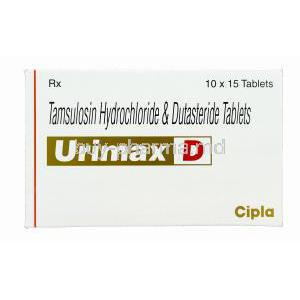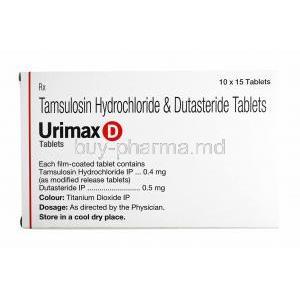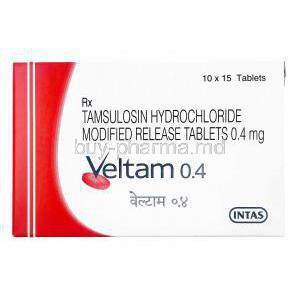Introduction to Urimax D
Overview of Urimax D as a Combination Therapy
Urimax D is a dual-action pharmaceutical formulation designed to target the symptoms and progression of benign prostatic hyperplasia (BPH). By merging two complementary agents, it addresses both urinary flow obstruction and prostate enlargement, offering patients a holistic approach to management.
Therapeutic Classification: α1-Adrenergic Blocker and 5α-Reductase Inhibitor
This medication belongs to two distinct yet synergistic therapeutic classes. Tamsulosin functions as an α1-adrenergic receptor antagonist, while Dutasteride is classified as a potent 5α-reductase inhibitor. Together, they provide relief from symptoms and contribute to long-term disease modification.
Clinical Importance in Urology and Men’s Health
Urimax D holds a pivotal role in urological practice. It not only alleviates lower urinary tract symptoms (LUTS) associated with BPH but also reduces the likelihood of complications such as acute urinary retention and the need for surgical intervention. For men’s health, it represents a cornerstone therapy in improving quality of life and preserving urinary function.
Urimax D Composition and Formulation
Active Ingredients: Tamsulosin Hydrochloride and Dutasteride
The formulation contains:
- Tamsulosin hydrochloride – enhances urinary flow by relaxing prostatic smooth muscle.
- Dutasteride – minimizes prostate volume by suppressing dihydrotestosterone synthesis.
Available Dosage Forms and Strengths
Urimax D is typically available in capsule form. Each capsule delivers a fixed dose combination, ensuring consistency and adherence in therapy.
Excipients and Formulation Details
The capsules contain pharmaceutical-grade excipients that stabilize the active ingredients and promote optimal absorption. Protective coatings enhance bioavailability and prolong shelf life.
Alfuzosin vs Tamsulosin
tamsulosin has a higher specificity for alpha-1A receptors, leading to fewer blood pressure-related side effects, while alfuzosin may have a better tolerability profile with fewer ejaculatory side effects and is sometimes a better option for patients with a sulfa allergy
Finasteride vs tamsulosin
Both medications help with urinary symptoms of BPH, such as a weak urine stream. Finasteride works by reducing the size of the prostate, which relieves pressure on the urethra (the tube that empties the bladder). Tamsulosin works by relaxing muscles in the prostate and bladder, improving urine flow.
Silodosin vs tamsulosin
Silodosin is more selective for the alpha-1A receptor, potentially causing less orthostatic hypotension, while tamsulosin blocks alpha-1A and alpha-1D receptors. Silodosin also has a higher risk of retrograde ejaculation, whereas tamsulosin carries a higher risk of headaches and dizziness.
Terazosin vs tamsulosin
Terazosin is taken once daily at bedtime, while tamsulosin should be taken 30 minutes after the same meal each day. Both medications are available as a lower-cost generic. Common side effects of terazosin include dizziness and weakness, while tamsulosin can cause headaches, dizziness, and abnormal ejaculation.
Doxazosin vs tamsulosin
Tamsulosin is considered a first-choice treatment for BPH, whereas doxazosin is not a first-choice for high blood pressure. Both medications can cause dizziness and low blood pressure, but tamsulosin is less likely to cause a sudden drop in blood pressure upon standing.
Tamsulosin and viagra
Combining these medications can lower your blood pressure and increase the risk of dizziness, lightheadedness, fainting, flushing, headache
Dutasteride vs finasteride
both are similar in how well they work for reducing BPH symptoms. Finasteride starts working more quickly, but dutasteride generally shrinks the prostate more.
Dutasteride and minoxidil
Dutasteride and minoxidil are two effective medications for treating male and female pattern baldness (androgenetic alopecia), with dutasteride reducing DHT levels to prevent follicle shrinking and minoxidil promoting blood flow and extending the growth phase. While minoxidil is FDA-approved, dutasteride is often used off-label for hair loss and is frequently combined with minoxidil for enhanced results.
Mechanism of Action: How Urimax D Works
Tamsulosin Mechanism: Selective α1A-Adrenergic Blockade
Tamsulosin selectively targets α1A-adrenergic receptors located predominantly in the prostate and bladder neck. By relaxing smooth muscle fibers, it diminishes resistance to urinary outflow and eases voiding difficulties.
Dutasteride Mechanism: Inhibition of Type I and II 5α-Reductase
Dutasteride suppresses both isoenzymes of 5α-reductase, leading to a profound reduction in dihydrotestosterone (DHT) levels. Lower DHT halts androgen-driven prostatic growth, gradually decreasing gland volume.
Synergistic Effects in Combination Therapy for BPH
When administered together, the rapid symptom relief of tamsulosin complements the long-term disease-modifying benefits of dutasteride. This synergy results in greater patient satisfaction and improved long-term outcomes.
Urimax D Tablet Uses
Management of Moderate to Severe Benign Prostatic Hyperplasia
Urimax D is primarily indicated for men suffering from symptomatic BPH, especially those with enlarged prostate glands.
Prevention of Disease Progression
Long-term administration reduces the risk of worsening symptoms and delays clinical progression.
Reduction of Risk of Acute Urinary Retention and Need for Surgery
By shrinking the prostate and enhancing urinary flow, Urimax D lowers the likelihood of acute urinary retention, thus reducing surgical interventions.
Off-Label Uses
Potential Use in Chronic Prostatitis and Lower Urinary Tract Symptoms
Some clinicians employ Urimax D in managing refractory cases of chronic prostatitis or persistent LUTS not linked solely to prostate enlargement.
Investigational Role in Urinary Bladder Outlet Obstruction
Studies suggest its benefit in bladder outlet obstruction where standard monotherapy is insufficient.
Dutasteride’s Studied Use in Androgenic Alopecia
Dutasteride has been evaluated for hair loss management due to its potent suppression of scalp DHT, though not officially approved in all regions for this indication.
Tamsulosin Uses in Females: Treatment of Kidney Stone Passage
Tamsulosin facilitates stone expulsion by relaxing the ureteral smooth muscles, a practice occasionally applied in clinical settings.
Dosage and Administration
Recommended Adult Dosage and Timing
The usual dose is one capsule daily, preferably taken at the same time each day to maintain steady plasma levels.
Tamsulosin dose
BPH: Recommended Dose: 400 mcg once daily. It should be administered approximately ½ hr following the same meal each day.
Best time to take tamsulosin
take tamsulosin in the morning, after breakfast or the first meal or snack of the day. This is because the highest levels of medicine are in your body 6 hours after you take it.
Maximum dose of tamsulosin
The maximum recommended dose of tamsulosin for Benign Prostatic Hyperplasia (BPH) management is 0.8 mg once daily.
Dose Adjustments in Renal or Hepatic Impairment
Patients with hepatic or renal compromise require cautious dose consideration, with regular monitoring recommended.
Duration of Therapy and Monitoring
Therapy is often prolonged, with clinical reassessments every 6–12 months. Monitoring includes prostate volume and prostate-specific antigen (PSA) levels.
Missed Dose and Discontinuation Guidelines
If a dose is missed, it should be taken as soon as remembered, unless it is near the next scheduled dose. Sudden discontinuation without medical advice is not recommended.
Important Precautions and Warnings
Orthostatic Hypotension and Risk of Dizziness
Patients may experience lightheadedness or fainting due to blood pressure fluctuations, particularly upon standing.
Risk of Intraoperative Floppy Iris Syndrome (IFIS)
Tamsulosin has been linked to IFIS during cataract surgery. Ophthalmologists should be informed if the patient has a history of use.
Potential Sexual Side Effects
Adverse effects may include decreased libido, erectile dysfunction, and ejaculatory disturbances. While often reversible, they can affect quality of life.
Long-Term Dutasteride Risks
Prolonged dutasteride therapy may influence fertility and has been linked to teratogenicity. Additionally, it requires vigilance in prostate cancer surveillance.
Contraindications
Known Hypersensitivity
Patients with allergies to tamsulosin, dutasteride, or related compounds should avoid this medication.
Women, Children, and Adolescents
Use is contraindicated due to risks of teratogenicity and lack of clinical benefit in these populations.
Severe Hepatic Impairment
Due to hepatic metabolism of both agents, patients with significant liver disease should not receive Urimax D.
Careful Administration and Patient Guidance
Administration to Elderly Patients
Elderly individuals require blood pressure monitoring and fall-risk assessment. Age-related sensitivity to side effects must be taken into account.
Administration to Pregnant Women and Nursing Mothers
Although not intended for use in women, exposure poses significant teratogenic risk. Handling broken or leaking capsules should be strictly avoided by women of childbearing potential.
Administration to Children and Adolescents
The safety profile in pediatric groups remains unestablished, and use is not recommended.
Special Care in Patients with Comorbidities
Patients with cardiovascular disease, renal impairment, or prior history of prostate cancer should be carefully evaluated before and during therapy. Continuous monitoring ensures optimal safety and efficacy.
Side Effects of Urimax D
Common Side Effects
Urimax D may cause a range of mild to moderate adverse reactions. These are generally transient and dose-related, though some may persist in sensitive individuals:
- Dizziness or lightheadedness, particularly upon standing
- Nasal congestion due to vasodilation of mucosal vessels
- Headache, often tension-like in quality
- Decreased libido and sexual desire
- Impotence or erectile difficulties
- Ejaculatory disorders, including retrograde or reduced volume
- Breast tenderness or mild enlargement in men
Less Common but Clinically Significant Adverse Events
Though rare, certain reactions can be medically consequential and warrant immediate evaluation:
- Angioedema – sudden swelling of the lips, tongue, or throat
- Depression – mood alterations and diminished affect
- Gynecomastia – pathological breast tissue growth in men
- Allergic skin reactions – rash, urticaria, or pruritus
Long-Term Safety Considerations
Prolonged therapy requires vigilance. Extended use of dutasteride can influence hormone balance, potentially altering fertility parameters and prostate health. Regular monitoring of prostate-specific antigen (PSA) and periodic clinical assessments are strongly recommended to mitigate long-term risks.
Tamsulosin Side Effects in Elderly
Older adults may be more sensitive to certain tamsulosin side effects, like dizziness and blood pressure changes. These side effects can raise the risk of falls.
Drug Interactions
Interaction with CYP3A4 and CYP2D6 Inhibitors
Urimax D is metabolized extensively via hepatic enzymes. Concomitant use with potent CYP3A4 or CYP2D6 inhibitors, such as ketoconazole, verapamil, or diltiazem, can elevate plasma concentrations, heightening the risk of adverse events.
Risk with PDE5 Inhibitors
Concurrent administration with phosphodiesterase type 5 inhibitors (sildenafil, tadalafil) can intensify vasodilatory effects, predisposing patients to symptomatic hypotension.
Interactions with Antihypertensives
Because tamsulosin already lowers vascular resistance, combining it with antihypertensive drugs can amplify blood pressure reductions, occasionally leading to orthostatic syncope or severe hypotension.
Dutasteride with Other Hormonal Therapies
Simultaneous use of dutasteride with other 5α-reductase inhibitors or hormonal agents may result in cumulative suppression of androgen pathways, necessitating caution and endocrine monitoring.
Overdosage and Emergency Management
Symptoms of Overdose
Excessive intake of Urimax D can provoke cardiovascular instability, often presenting as:
- Marked hypotension
- Severe dizziness or fainting
- Tachycardia as a compensatory mechanism
Supportive Treatment and Monitoring
Management is largely symptomatic. Vital signs must be closely observed, with intravenous fluids administered to maintain hemodynamic stability. Continuous cardiac monitoring is advisable in pronounced cases.
Role of Gastric Lavage and Activated Charcoal
Early gastric lavage or administration of activated charcoal may be considered if ingestion is recent. These interventions help reduce systemic absorption of the active ingredients.
Lack of Specific Antidote
No definitive antidote exists for Urimax D overdose. Hence, supportive care and monitoring remain the cornerstone of emergency management.
Storage and Handling Precautions
Recommended Storage Conditions
Urimax D should be stored at controlled room temperature, ideally between 15°C and 30°C. It must be safeguarded against excessive humidity and direct sunlight exposure to preserve stability.
Shelf Life and Stability Information
Each package bears an expiry date beyond which potency and safety cannot be assured. Adherence to these timelines is crucial to therapeutic efficacy.
Handling Precautions
Capsules should not be broken or crushed. Dutasteride can be absorbed through the skin; direct contact should be avoided, especially by women of childbearing potential. In the event of accidental contact, the affected area should be thoroughly washed with soap and water.
Disposal Guidelines
Unused or expired medication should be disposed of responsibly. Patients are advised to follow local pharmaceutical waste protocols, avoiding general household disposal to minimize environmental contamination.
Urimax D, Tamsulosin / Dutasteride FAQ
- What is Urimax D used for?
- How long can Urimax D be taken?
- What is the difference between Urimax and Urimax D?
- What are the side effects of the drug Urimax?
- Is Urimax safe for kidneys?
- What are the benefits of Urimax tablets?
- Does Urimax D increase blood pressure?
- What is the best time to take Urimax D?
- Is Urimax D a steroid?
- Does Urimax remove a kidney stone?
- How long does it take for Urimax to work?
- Does Urimax make you sleepy?
- Is Urimax D safe?
- Can Urimax D shrink prostate?
- What is the major side effect of tamsulosin?
- What are the long-term effects of taking dutasteride?
- When is the best time to take dutasteride and tamsulosin?
- How long does it take for dutasteride to shrink the prostate?
- Why does tamsulosin stop you from ejaculating?
- Can tamsulosin make you pee more at night?
- Can dutasteride affect the heart?
- Can dutasteride cause permanent erectile dysfunction?
- Who cannot take tamsulosin?
- Can dutasteride reduce PSA?
- Can I take Cialis with tamsulosin?
What is Urimax D used for?
The medication Urimax D is primarily used to alleviate symptoms of hyperplasia, a condition that affects men. This condition can cause a range of issues, including problems with painful ejaculation, difficulty urinating, and accidental passing of urine. Some men also experience trips to the bathroom at night.
How long can Urimax D be taken?
2 to 4 weeks
What is the difference between Urimax and Urimax D?
The key difference between Urimax and Urimax D comes down to their ingredients. Urimax is made up of tamsulosin, whereas Urimax D has a combination of tamsulosin and dutasteride.
What are the side effects of the drug Urimax?
- Hpotension
- Dizziness
- Decreased libido
- Difficulty sleeping
- Breast tenderness
Is Urimax safe for kidneys?
Yes
What are the benefits of Urimax tablets?
The medication Urimax D is primarily prescribed to alleviate symptoms associated with hyperplasia, a condition affecting men. These symptoms can include difficulties related to health, such as ejaculation issues or urinary problems like struggling with urination, involuntary passing of urine, and repeated nighttime trips to the bathroom.
Does Urimax D increase blood pressure?
No
What is the best time to take Urimax D?
30 minutes after a meal
Is Urimax D a steroid?
No
Does Urimax remove a kidney stone?
Yes
How long does it take for Urimax to work?
4-8 hours
Does Urimax make you sleepy?
Yes
Is Urimax D safe?
Yes
Can Urimax D shrink prostate?
Tamsulosin relaxes the muscles in the prostate and the urethra, which is the tube that carries urine out of the body. While Dutasteride helps shrink the prostate—the two work together to make it easier for urine to pass through.
What is the major side effect of tamsulosin?
- Hypotension
- Ejaculation issues
What are the long-term effects of taking dutasteride?
NAFLD, IR, T2DM, dry eye disease and potential kidney disease
When is the best time to take dutasteride and tamsulosin?
To get the results, try taking it at the same time every day, about 30 minutes after you've eaten a meal.
How long does it take for dutasteride to shrink the prostate?
4 years
Why does tamsulosin stop you from ejaculating?
Tamsulosin affects the muscles that play a role in the process of ejaculation.
Can tamsulosin make you pee more at night?
Yes
Can dutasteride affect the heart?
Yes
Can dutasteride cause permanent erectile dysfunction?
Yes
Who cannot take tamsulosin?
It's not recommended that women take tamsulosin.
Can dutasteride reduce PSA?
Yes
Can I take Cialis with tamsulosin?
When you take these medications together, they can cause your blood pressure to drop, making you more likely to feel dizzy or lightheaded.



















